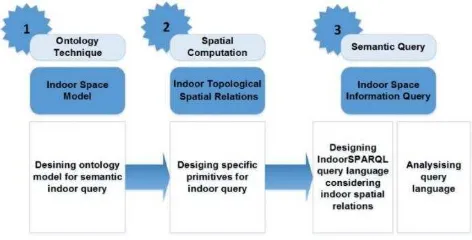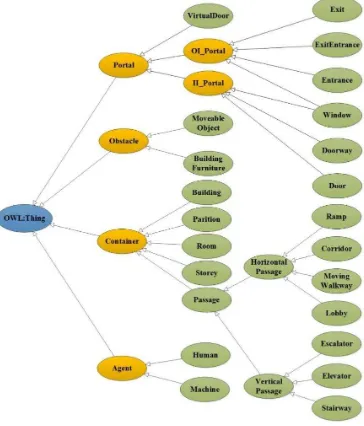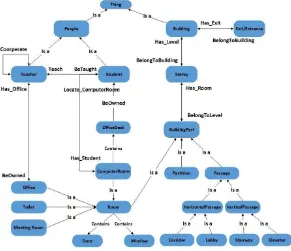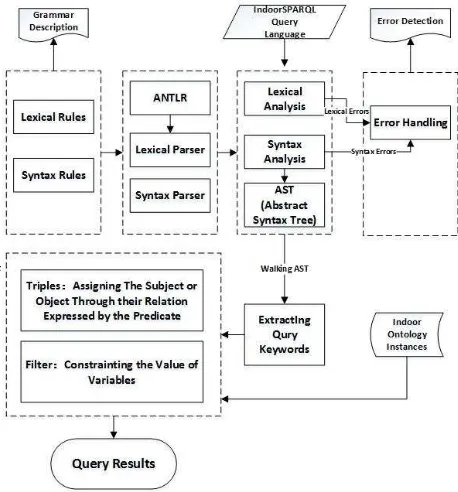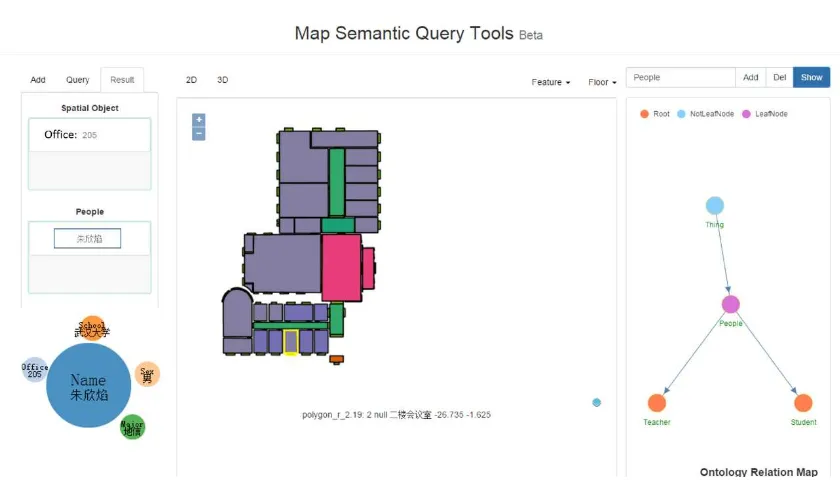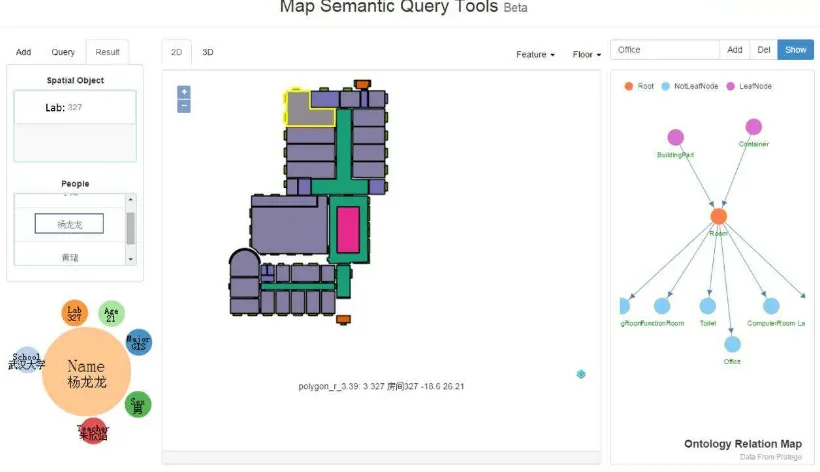Research on Extension of SPARQL Ontology Query Language Considering the Computation
of Indoor Spatial Relations
Can Li1, Xinyan Zhu1, Wei Guo1, Yi Liu2, Liang Huang1
1State Key Laboratory of Information Engineering in Surveying, Mapping and Remote Sensing, 129 Luoyu Road, Wuhan, China 2School of Geodesy and Geomatics, Wuhan University, 129 Luoyu Road, Wuhan, China
Email: [email protected]
KEY WORDS:Indoor Space; Ontology; Semantic Query; SPARQL; Indoor Spatial Relation
ABSTRACT:
A method suitable for indoor complex semantic query considering the computation of indoor spatial relations is provided According
to the characteristics of indoor space. This paper designs ontology model describing the space related information of humans, events
and Indoor space objects(e.g. Storey and Room) as well as their relations to meet the indoor semantic query . The ontology concepts
are used in IndoorSPARQL query language which extends SPARQL syntax for representing and querying indoor space. And four types
specific primitives for indoor query, “Adjacent”, “Opposite”, “Vertical” and “Contain”, are defined as query functions in
IndoorSPARQL used to support quantitative spatial computations. Also a method is proposed to analysis the query language. Finally
this paper adopts this method to realize indoor semantic query on the study area through constructing the ontology model for the study
building. The experimental results show that the method proposed in this paper can effectively support complex indoor space semantic
query.
1. Introduction
Recently, human activities have expanded from outdoor to
indoor space(Lee K et al., 2013). Since the building construction
is becoming more and more complex, to better support indoor
activities, there is urgent need to implement query services of
indoor space. Based on geometric model and symbolic
model, the current indoor query services focus on geometric and
simple semantic query, such as range query and k nearest
neighbor query. A lattice-based semantic location model (LSLM)
for the indoor environment was proposed which can better
support semantic navigation and the nearest neighbor query for
indoor space(Li D et al., 2008). Also, methodologies on range
query(Yang B et al., 2009) and k nearest neighbor query(Yang B
et al., 2010) for indoor space were carried out. However, all
models above are still not enough to support complicate semantic query of indoor space, e.g. “professor whose office is in the opposite of professor Zhu’s office”. There are three
reasons as follow.
1. Both geometric and symbolic coordinates are difficult to
represent rich semantics of indoor space, such as space
properties, space related information of humans and events.
2. Some spatial relations widely and specially used in the i ndoor space have been ignored, such as “opposite”, “upstairs”, “downstairs”, etc.
3. It is difficult to model all relations between different indoor
regions in advance, which may lead to failure of space
query.
The semantic model of indoor space can describe the attributes
of different indoor structures as well as their relations which
provide the basis for complex semantic query. This modeling
method is usually associated with ontology.However, nowadays
few research focuses on ontology query language for standard
OWL(Ontology Web Language), and most focuses on the
standard query language for RDF( Resource Description
Framework) which is the basis of OWL. SPARQL is a kind
of query language for RDF to query and access any data
resources that can be mapped to RDF model. The GeoSPARQL
providing the expression of geometry and geometric query functions, such as “ogc:equals”, “ogc:touches”, and “ogc:overlaps”. With GeoSPARQL query language, topological relations between instances can be queried. However, the
relations expressed by the geometric query functions are limited
to basic topological relations, and some spatial relations widely
and specially used in the indoor space have been ignored, such as “opposite”, “upstairs” and “downstairs”.
Aiming at these shortcomings, this paper proposes an
ontology model to support semantic query of indoor space. The
ontology concepts are used in IndoorSPARQL query language
which extends SPARQL syntax for representing and querying
indoor space. We also design four types specific primitives for indoor query, “Adjacent”, “Opposite”, “Vertical” and “Contain”, which are defined as query functions in IndoorSPARQL used to
support quantitative spatial computations. Finally, a method is
proposed to analysis the query language.
2. Methodology
The core part of this research is divided into three sections as
shown in Figure 1. First, an ontology model is designed to
support semantic query of indoor space. Second, specific
primitives for indoor query are proposed, and the
basic calculation method is carried out. Third, IndoorSPARQL
query language is designed for representing and querying indoor
space, also a method is proposed to analysis the query language.
Figure 1.Overview of proposed methodology
2.1 Ontology Model
An ontology is an explicit specification of concepts and
describable relationships in the knowledge of a domain(Gruber,
T. R.,1995). Indoor space can be abstracted as a set of ontology concepts, such as “Building”, “Storage”, “Passage”, etc. Space semantics like properties, relations can be easily defined as data
properties and object properties of ontology concept. Figure 2
shows the ontology concepts based on the cognition of indoor space. The concept “Thing” labelled in blue ellipse is the basic class. It contains four subclasses labelled in yellow ellipses, including “Portal”, “Obstacle”, “Container” and “Agent”.
Based on the ontology concepts of indoor space, this paper
designs an ontology model for the study area--LIESMARS
building to meet the demand of semantic query of indoor space
as shown in Figure 3. This ontology model describes the space
related information of humans(e.g.Teacher and Student), events
and Indoor space objects(e.g. Storey and Room) as well as their
relations, such as the “Teach-BeTaught” relation between teachers and students, and the “Has_Office-Beowned” relation between teachers and offices. For each ontology concept of this
model, this paper defines some data properties used for indoor
semantic query.
Figure 3. The Ontology Model for Semantic Query
2.2 Specific Primitives for Indoor Query
This paper designs four types specific primitives for indoor query: “Opposite”, “Vertical”, “Adjacent” and “Contain”. These four primitives separately express the “opposite relation”, “upstairs-downstairs relation”, “adjacency relation” and “containing relation” between indoor structures. These primitives are defined in IndoorSPARQL query language as
query functions used to support quantitative spatial
computations. In this part, we take "opposite relation" for
example to introduce its definition and the method of
computation for different ontology concepts.
The "opposite relation": Based on the building ontology model,
the relation is defined and calculated under some constraints:
The objects of calculation must belong to the same floor of
the building.
The "opposite relation" is only be calculated on those sides
of the function areas where there are entrances.
There must exit a function area as a reference object to define the ‘opposite relation’ between the objects of calculation.
For the third constraint, this paper takes the "HorizontalPassage" which is the sub-class of ‘Passage’ in the building ontology as the reference object. That is, the computational model employs
the function areas, such as "corridor", "lobby" to judge the
existence of "opposite relation" between objects.
The ontology concepts which are suitable for the constraints
of "opposite relation" are: "Room" class, "VerticalPassage" class,
"BuildingDoor" class as well as their sub-classes. Different
computational models are developed according to different
ontologies for "opposite relation".
For the ‘Room’ class: A room of a building will have a
door as an entrance. The entrance, as an auxiliary object of
calculation, can make the calculation meet the second
constraint. Firstly, for a specific room of a building, we can get the candidate rooms that may have ‘opposite relation’ with it through the reference object, such as corridor or
lobby based on the set of instances. The second step is to
calculate the angle to judge whether there exists "opposite
relation" or its sub-relation between them.
For the "VerticalPassage" class: The "VerticalPassege"
class includes the "Elevator", "Escalator", "Stairway"
sub-classes. For this opening function areas, there is an
ontology class named "VirtualDoor" owning the similar
meaning to the "Door" class that represents the connection
areas between function areas of the building. Therefore,
for the "VerticalPassage" class, the "VirtualDoor" class can
help calculation to meet the second constraint of "opposite
relation".
For the "BuildingDoor" class: The calculation can be
carried out through reference object—the
"HorrizontalPassage" class to judge whether there exists a
kind of "opposite relation" or its sub-relation The International Archives of the Photogrammetry, Remote Sensing and Spatial Information Sciences, Volume XL-4/W5, 2015
2.3 IndoorSPARQL Query Language
This paper extends SPARQL syntax to design IndoorSPARQL
query language by defining ontology concepts as well as data
and object properties as vocabularies for representing indoor
spatial information and by defining specific primitives as query
functions used to support quantitative spatial computations.
Figure 4 shows an example of semantic query of indoor space.
The basic grammar of the query language is introduced as
follow based on this example.
Figure 4. Example Query: Find teacher whose office is in the opposite of teacher Zhu’s office
Syntax for IRIs
The “PREFIX” keyword associates a prefix label with an
IRI(Internationalized Resource Identifiers). A prefixed
name is mapped to an IRI by concatenating the IRI
associated with the prefix and the local part.
For example:
PREFIX IndoorOWL: http://www.semanticweb.org//Ontology.owl#
Syntax for Literals
The general syntax for literals can be a string, a decimal
number or a bool variable. subject or object part, and the predicate part represents a
relationship between subject and object.
For example:
?Teacher_Zhu IndoorOWL:office ?Room_Zhu .
Syntax for Filters
A constraint, expressed by the keyword “FILTER”, is a restriction on solutions over the whole group in which the filter appears. Logical operator like “&&” or “||” and the specific primitives can be used to constraint the
relationship between instances.
For example:
Filter Opposite(?Room_X, ?Room_Zhu).
2.4 Analysis of Query Language
The process of parsing the query language is shown in Figure 5.
First, grammar for this query language is designed, and a tool
named ANTLR is used to generate the lexical and syntax parser,
through which a query expression can be determined whether it
conforms to the grammar or not. Then, the query expression will
be transformed into an abstract syntax tree by the parser. Finally,
code production walks syntax tree and obtains information from
ontology instances of indoor space to complete the query process.
Figure 5. The Process of Parsing IndoorSPARQL Language
3. Experiment
For the experiment, the study area is LIESMARS building.
Based on the ontology model this paper designs, instances for
the indoor space are constructed by the software named Protégé.
Two examples of indoor semantic query which use
IndoorSPARQL query language are provided with their results
Example Query 1: Find the teacher and his office which is in the opposite of room 204.
PREFIX IndoorOWL:
<http://www.semanticweb.org/dell327/ontologies/2014/10/Ont ology1415628375607.owl#>
Select ?Teacher_X ?Room_X Where
{
?Room_204 a IndoorOWL:Office .
?Room_204 IndoorOWL:Na e 0 . ?Teacher_X a IndoorOWL:Teacher.
?Teacher_X IndoorOWL:Has_Office ?Room_X
Filter Opposite(?Room_204, ? Room_X). }
The query results are visualized in Figure 7. The basic
information of the teacher is displayed in the left dialog, and his
office is highlighted on the map.
Figure 7. The Results of Example Query 1
Example Query 2: Find the laboratory on the third floor of teacher Zhu’s students, as well as these students.
PREFIX IndoorOWL:
<http://www.semanticweb.org/dell327/ontologies/2014/10/Ont ology1415628375607.owl#>
Select ?Room_X ?Student_Zhu Where
{
?Teacher_Zhu IndoorOWL:Name "朱欣焰" . ?Teacher_Zhu IndoorOWL:Teach ?Student_Zhu . ?Student_Zhu
IndoorOWL:Locate_ComputerRoom ?Room_X .
?Roo _X I doorOWL:LevelNo .
}
The results are visualized in Figure 8, including the information
of these students and their laboratory highlighted on the map. The International Archives of the Photogrammetry, Remote Sensing and Spatial Information Sciences, Volume XL-4/W5, 2015
Figure 8. The Results of Example Query 2
4. Conclusion
According to the characteristics of indoor space, query
language IndoorSPARQL expanding the SPARQL syntax is
designed to support the indoor semantic query considering the
computation of indoor spatial relations. The proposed method
can effectively meet rich indoor activities. This method has
the following advantages:(1)The ontology model provides
a complete and clear expression for indoor space and the space
related information of humans, events and Indoor
space objects(e.g. Storey and Room) as well as their relations,
providing the basis for complex semantic query;(2) Specific primitives for indoor query, “Adjacent”, “Opposite”, “Vertical” and “Contain”, defined as query functions in IndoorSPARQL
can support quantitative spatial computations semantic query in
the indoor;(3)This paper also designs query language
IndoorSPARQL to support the proposed method of indoor
semantic query. However, there are also some shortcomings in
the work ,our future research will focus on:(1) Improving the
structure and function of the query language IndoorSPARQL;(2)
Improving the calculation model of indoor spatial relations;(3)
Optimizing the Analysis of the query language to improve
the query efficiency
5. References
Lee, K. and Kang, H. and Lee, J., 2013. Topological Analysis in
Indoor Shopping Mall using Ontology. Journal of the Korean
Society of Surveying, Geodesy, Photogrammetry and
Cartography, 31(6-2), pp. 512-520
Patrick, M. and Mahsa, G. and Hassan, A., 2009. ONALIN:
Ontology and Algorithm for Indoor Routing. In:2009 Tenth
International Conference on Mobile Data Management: Systems,
Services and Middleware, pp. 720-725.
Gruber, T. R. 1995. Toward principles for the design of
ontologies used for knowledge sharing. International
journal of human computer studies, 43(5), pp. 907-928.
Li, D. and Lee, D. L., 2008. A Lattice-Based Semantic Location
Model for Indoor Navigation. In: The Ninth International
Conference on Mobile Data Management, pp. 17-24.
Yang, B., Lu, H. and Christian S. Jensen, 2009. Scalable
Continuous Range Monitoring of Moving Objects in Symbolic
Indoor Space. In: Proceedings of the 18th ACM conference on
Information and knowledge management, pp.671-680.
Yang, B., Lu, H. and Christian S. Jensen, 2010. Probabilistic
threshold k nearest neighbor queries over moving objects in
symbolic indoor space. In: Proceedings of the 13th International
